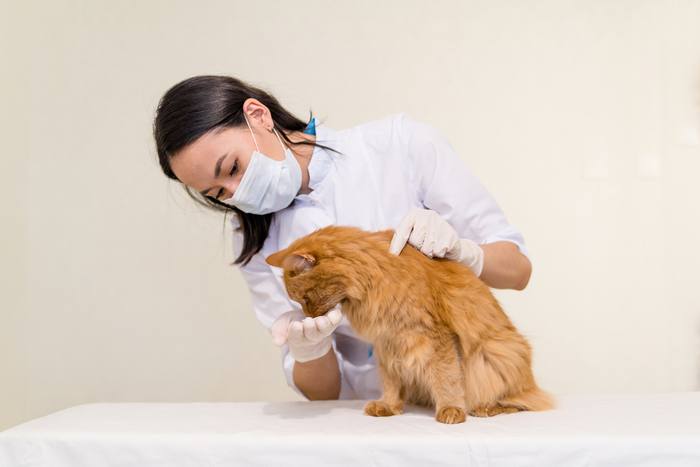
Zonisamide, which may also be known by the brand name Zonegran, is an anticonvulsant drug that may be used in some cats who are experiencing seizure disorders. In this article, you’ll learn how zonisamide works, what situations it may be used in, side effects to look for in cats, and some frequently asked questions.
Zonisamide for Cats Overview

About Zonisamide in Cats

Zonisamide has been studied much more in dogs than in cats, and it is not typically thought of as a first-line choice anticonvulsant for kitties.
Zonisamide is an anti-seizure medication used in veterinary medicine for cats in a variety of cases where a seizure disorder of some kind is present.
A seizure occurs when a sudden discharge of electrical signals occurs in the brain that leads to involuntary activity of the body, or seizing.
Patients experiencing a seizure often lose consciousness and the body may then exhibit appearance of muscle spasms, convulsions, or a pet may go completely rigid with stiff muscles. Drooling, urination, and defecation may also occur.
Seizures can occur for a variety of reasons. The presence of brain tumors and inflammatory lesions in the brain can be one set of causes where something structurally abnormal is present. Pets may also develop seizures from certain underlying medical disorders like liver and kidney disease, toxin ingestion, or if a diabetic cat’s blood sugar goes too low.
But seizures can also occur secondary to a condition known as idiopathic epilepsy. With epilepsy, the neurologic overexcitement occurs leading to a seizure, but there is no known cause. Pets with epilepsy often have normal MRI (magnetic resonance imaging) scans of the brain.
As an anticonvulsant medication, zonisamide helps to decrease the chance of a seizure occurring and reduce seizure frequency by reducing the abnormal electrical activity that leads to seizure episodes. There are several types of anti-seizure medications available, each working in a different way and with some being more effective in some cases than others.
What Does Zonisamide Do for Cats?

It is helpful to note that unlike in dogs, where zonisamide is typically dosed every 12 hours, zonisamide for cats is usually only dosed once a day.
Zonisamide’s mechanism of action is not specifically known. However, it is thought that it works at sodium and calcium channels which can help to stabilize nerve cells and suppress the domino effect of electrical activity that leads to a seizure.
Zonisamide also affects certain neurotransmitters within the brain, namely supporting serotonin and dopamine (mood and pleasure hormones) though not affecting GABA (calming hormone). Zonisamide can also purportedly help to scavenge damage-causing free radicals within the brain.
Zonisamide has been studied much more in dogs than in cats, and it is not typically thought of as a first-line choice anticonvulsant for kitties. More common first-line choices may include phenobarbital or levetiracetam (Keppra).
More often, zonisamide may be turned to when a first-line anticonvulsant is not adequately controlling seizures, or if a cat experiences unacceptable side effects of another anticonvulsant, which leads to exploring other medication choices.
While there has not been a great deal of research on zonisamide use in cats as a single anticonvulsant choice, or monotherapy, there have certainly been anecdotal reports from individual cases where a cat has done well with it.
Zonisamide also tends to be a relatively inexpensive medication when dosed for a cat, which may also highlight it as a favorable choice in some cases.
Zonisamide is also typically only dosed once daily in cats, which may be a more favorable option compared to phenobarbital, which requires dosing every 12 hours, or Keppra, which most often requires dosing every eight hours.
Side Effects of Zonisamide for Cats

Side effects of zonisamide include loss of appetite, diarrhea, vomiting, balance issues, and sedation/drowsiness.
There can be a higher risk of side effects with zonisamide for cats.
In one study, about 50% of cats treated with zonisamide experienced adverse effects, which most often included loss of appetite, diarrhea, vomiting, balance issues when walking (ataxia), and sedation/drowsiness (somnolence).
In another review of case reports, a majority of cats did not appear to have side effects on zonisamide. However, the efficacy or benefits of the medication as well as the safety profile as a lone treatment was considered weak.
Zonisamide is considered to be a teratogen, meaning that it can lead to birth defects if used in pregnant patients. This has not been documented specifically in cats, but has been found to be the case in mice, rats, dogs, and humans.
For this reason, it is recommended to administer any oral zonisamide medication to your cat using disposable gloves.
Because zonisamide is largely metabolized by the liver and excreted by the kidneys, it should be used cautiously in pets that have any pre-existing liver or kidney disease.
If you are ever concerned that your kitty may have developed side effects while using zonisamide, or if an overdose is suspected, contact your veterinarian, the ASPCA Animal Poison Control Center (1-888-426-4435), or Pet Poison Helpline (1-855-764-7661) immediately for further advice.
Zonisamide for Cats Dosage

It is advised that pet owners wear disposable gloves when administering zonisamide.
The dosage for zonisamide for cats has a great deal of variation. A veterinarian may make dose adjustments depending on whether it is being used alone or in conjunction with another medication. It may also be started out at a lower dosage to observe how a kitty tolerates it before increasing the dose further.
Because of these variations and precautions, it is best for an attending veterinarian to determine the proper oral administration dosage for zonisamide for cats and for these reasons, a specific dose is not provided.
It is helpful to note that unlike in dogs, where zonisamide is typically dosed every 12 hours, zonisamide for cats is usually only dosed once a day.
Although adverse effects are certainly possible with zonisamide, it is important to not stop the medication abruptly, especially if your cat has been on it for any length of time. Always speak first with your vet.
Stopping any anticonvulsant medication abruptly can lead to rebound seizures occurring.
Zonisamide is unlikely to have any drug interactions with other commonly prescribed medications. However, most notably, the dosage may need adjustment if a kitty is also on phenobarbital for seizures.
Conclusion

Zonisamide is a medication commonly used to aid in addressing seizure disorders in pets. In cats, it may be considered more as a back-up or add-on therapy for seizures versus a primary first-line choice.
The risk of adverse effects may be higher in cats, and so a cat’s tolerance to the medication may be an important factor in determining whether or not to use it as a treatment choice.
Frequently Asked Questions
Is zonisamide safe for cats?
All medications can carry with them a risk of side effects, though zonisamide may have a higher rate in kitties. According to one study, about 50% of cats experienced adverse effects including poor appetite, vomiting, diarrhea, and drowsiness. Zonisamide may also not be an advisable choice in cats with pre-existing liver or kidney disease.
In cats without pre-existing liver or kidney disease who appear to tolerate the medication well, it could otherwise be considered a safe medication to continue, especially if it is helping to manage a seizure disorder.
How long does it take for zonisamide to work in cats?
In cats, zonisamide has an onset of action of about four hours. Like many anticonvulsant medications, a certain period of time of doses may be required to reach a “steady state” where drug levels are consistently high enough to prevent seizures.
Any time a patient is actively convulsing for more than three minutes, immediate veterinary care should be sought. Also, never try to orally administer an anticonvulsant medication while a pet is actively seizing, as this greatly increases the risk for a bite injury to the person trying to give the medication, is unlikely to be properly swallowed by the patient, and could present a choking hazard.
What is the side effects of zonisamide?
Zonisamide can have several adverse effects, including a drop in appetite, vomiting, diarrhea, balance issues when walking (which is termed ataxia), and somnolence (excessive drowsiness).
In some studies these effects have been seen in about 50% of cats, while in other studies the percentages have been found to be lower.
What type of seizures does zonisamide treat?
Zonisamide is most often used in pets as an add-on therapy for treatment of epilepsy. Epileptic seizures are ones that occur from an overexcitement of electrical activity within the brain. In idiopathic epilepsy, there is no known cause, though sometimes outside triggers, like stress or loud noises, may be connected.
Seizures may also be caused by a lesion within the brain, like a tumor or inflammatory mass. A previous trauma that led to damage of brain tissue may also contribute to a seizure disorder.
Like all anticonvulsants, zonisamide may be used in any of these cases where seizures are occurring, as a way of reducing their likelihood to occur by quieting the electrical overactivity within the brain by different mechanisms.
However, different anticonvulsants have different mechanisms of action and different degrees of efficacy. While zonisamide may be used in the case of any seizure disorder, it is most often used in cats as an add-on or secondary choice to help with seizure control.








Does Zonisamide cause blindness in cats that have epilepsy? Help please
Hi Tina, thanks for your question, though I’m sorry to hear that your kitty may be having vision problems. Blindness is not a listed side effect for zonisamide reported in dogs, cats, or humans. If your kitty has lost vision, I would be more concerned that an underlying medical condition would be responsible. This could occur secondary to a neurologic disorder contributing to seizures, or from a separate disease condition (like a primary eye issue or high blood pressure) that is occurring independent of your cat’s seizure disorder. If you haven’t yet, it would be important to consult with your veterinarian or veterinary neurologist to determine an underlying cause for the vision loss.
compounded zonisamide -liquid.
Can this be given less frequently than once a day? Cat drools excessively when taken and the taste must be terrible..
Hi Darden, if this medication is being given for seizures, giving it less frequently than it needs to be due to a concern about taste may more likely lead to less efficacy for a seizure disorder. A better strategy would be to work with your veterinarian and see if you can get a compounded form for the zonisamide that is in a flavored tablet or liquid form that would be more palatable for your kitty.
Would you be able to provide me with a link to the study for the 50% adverse reaction/inappetance study? I’d love to have a read. My vet insists it’s not a common reaction and I’ve seen the 50% reaction noted elsewhere as well but can’t find the study myself.
Hi Spencer,
Yes, I tracked down a link to the study from 2008. Zonisamide was apparently well tolerated at 10mg/kg per day. The group of cats where 50% showed more side effects was at a dosage of 20mg/kg per day. It’s important to point out that typical doses for cats would rarely exceed 10mg/kg per day.
https://journals.sagepub.com/doi/pdf/10.1016/j.jfms.2008.01.006
Hi Dr. Chris – My vet just prescribed my cat 25mg twice a day. She said we could start with just once a day. Is 25mg too much even once a day? I’m concerned about giving it to him after he had his second seizure in 8 weeks. Thanks for your advice in advance.
Hi Joni, I can concur with the dosing amounts your vet prescribed. The dose for an average 10lb cat would be between about 20 and 45mg. Zonisamide comes commercially available in a 25mg size, so this is a very common place to start. The medication has a longer half life, so some will dose it initially at once daily, but twice daily is the most commonly recommended. After one seizure, we may just wait and see if another one occurs at all. But after a second one, many veterinarians will discuss anticonvulsant therapy. The concern is that the next seizure may occur even sooner, or last longer, or groups of seizures may occur. We try to reduce the risk of episodes getting harder to control by getting started on a medication as soon as is reasonable. I hope that makes sense and is helpful information.
Hi Dr. Chris, the vet neurologist prescribed 50 mg every 24 hours. He’s only 2 years old and weighs 3.75 kgs. He is lethargic and completely lost his appetite and coordination.
How safe/ effective is it if I give him the pill every 48 hours instead? I read somewhere that its effect in cats can last up to 48 hours.
The neurologist is very adamant that we shouldn’t change anything and I understand where they’re coming from – while he hasn’t had a seizure in over 3 weeks, he barely has quality of life now. Thanks in advance!
Hi Jess,
While zonisamide has a longer half life in cats that can allow it to be dosed less frequently, there are no published doses I’ve found suggesting it would still be effective if given every 48 hours. Perhaps the neurologist is hoping to get the seizure disorder under control quickly in the hopes of tapering the dose down at some point. The dose your kitty is getting is on the higher end but if this is the only seizure medication your cat is on, it’s possible a higher dose is needed initially for better control in your neurologist’s experience. I would try to touch base with them again if you haven’t in regards to the side effects your kitty is experiencing. Obviously, you can’t continue with those side effects forever, so I would hope that either they expect the side effects to be transient and lessen after a few weeks, or they hope to slowly lower the dose if good control has initially been established.
My cat is in acquired epilepsy after surviving neurological FIP (12yr old presented with blindness and seizures, all other numbers good). Initially he was on gabapentin for treatment support, and keppra for seizures. First antiviral began to fail and cluster seizures began. Different antiviral and zonisamide began and he stabilized. Considered in remission from FIP now (new science tho)
Much of this has been seat of the pants and hail mary work. He regained limited vision. He had sn abscess that was hard to heal, dropped 2lbs, never gained back, antibiotics caused us to increase keppra.
All literature imdicated zonisamide every 12 hours. My vet is young but was willing to work on his case. We still have breakout seizures in early am, and issues with appetite, diarrhea, and ataxia at timest. Could 50mg at 7am and 7pm be our problem? If so, how do we taper or shift without risking breakthrough seizures? Does he need a higher than 50 every 24? Diagnosis was Aug3 2023 and 2 vets and a neurologist leaned towards eu. But a rescue had a grant for FIP work and he had nothing to lose and was not suffering, so we tried. Every day has been 5 or more capsules etc. Hogan is walking, eating, looking at birds through the windows. But I dread seizures. This article made me think there is another step.
Hi Chrystal,
I’m having a little trouble following what amount or frequency of zonisamide your kitty is actually receiving. You mention 50mg in 24 hours but also if giving it at 7am and 7pm is the “problem”. Does this mean he’s getting 50mg once a day and you’re wondering if it can be given twice a day?
Once daily dosing can be used in cats, especially if they are on another anticonvulsant, because in cats zonisamide has a very long half life (it lasts longer in their bodies compared at least to dogs. However, if you are not getting adequate seizure control, it may be reasonable to use it twice a day. This has to be balanced with side effects, which can be dose-dependent with zonisamide.
Adequate seizure control for any condition can depend a lot on the nature of the cause of seizures. I do think it’s amazing that your cat has been treated to some degree of success for FIP. But I’m not sure how much is really known about successfully managing the continued neurologic effects.
I have been giving twice a day, because we were not aware that once a day was an option. So 50mg 2xday, plus 325 keppra 3xday, with additional gabapentin in low doses I am afraid to remove in case it is bridging. Also daily 6mg cerenia, and probiotics and fiber. Mirataz for appetite. B12 shot bi weekly.
I
Fda approved molnupiravir is the antiviral of choice with what I know now for FIP, a long treatment that requires liver support and blood tests, but it is effective enough that a trial is going on in Colorado. I am always glad to discuss his case, although it is not the main topic here. Finding vet support in the US is not easy, but there is international support and advice that helped, since drugs are approved for use out there already for some years.
My question is: Hogan is on 50mg 2x a day. We never tried once a day. How could we safely do that, since it is possible that could be better for him? Merck did not mention this information about cat dosing, so we did not know. His appetite is low, he is still not confident jumping. Nausea is an issue we associate with zonisamide.
Neuro FIP can cause high cranial pressure and lesions in the brain, which respond to treatment and resolve when the virus is killed, but lesions can have caused enough damage that ideopathic epilepsy is sometimes the result. Many neuro cats escape this and have full recovery if caught soon enough. Hogan was doing very well until mid treatment when that first antiviral, not molnupiravir, failed, possibly a tolerance was reached or a product quality issue (not fda approved or pharmaceutical grade) and that relapse caused the additional damage.
Hi Chyrstal,
Thank you for the clarification. There really is no simple solution that doesn’t come without potential risk. It is possible that giving the zonisamide once daily may provide control. And if you do feel that the zonisamide is contributing to side effects, which can be dose-dependent, this may be worth taking the risk. Giving the dose in the evening may provide the best chance to offset the early morning seizures. Besides discussing with your vet if adjusting the gabapentin dose or frequency may help offset more episodes, starting phenobarbital may be the only option left to add for more seizure control. While keppra is very safe, it generally seems like his dose is currently fairly high and I don’t know that there’s room to increase it.
Thank you very much. I have reached out to my vet about this; I am very fortunate to have good communication with him. In my 40 years of various cat affliction experience, seizure disorder is new, It is hard to learn about, and I monitor everything looking for patterns. Ear temperature, stool consistency, distraction levels, grooming, hydration, and so forth. Obviously, quite boring at parties.
This information about the drug is helpful to us.
Hi Dr.,
Our cat began presenting with seizure activity 2 years ago. He was prescribed 0.12ml of Phenobarbital 2 times daily. He hasn’t had a single episode since. We took him into the vet for dental work and when they tested his bloodwork, it was noticed that his RBCs were low becoming borderline anemic. We were told that it is a rare side effect especially in cats so the dr wants to now prescribe that he goes on Zonisamide. The dr wants to ween the pheno into the Zonisamide. Our concern is the ween is going to cause breakthrough seizures that we will not be able to get under control. We haven’t started the ween or new medication yet due to it requiring it to ordered into the clinic. Just wondering if you have you ever seen/worked on any similar cases with either a positive or negative outcome with the transition of treatments.
Hi K,
Your vet is correct that blood-related abnormalities can be a rare side effect of phenobarbital use and if related, would be expected to resolve once the medication is discontinued.
However, you are also right to have some concern about refractory/breakthrough seizures during a transition period.
In my experience, the key is to do it slow and work up to a therapeutic level of the new anticonvulsant before starting to wean off the old one to reduce that risk. It has to be balanced with any side effects of a new medication or using two anticonvulsants together. We can see some lethargy type effects when adding in additional anticonvulsants, but there can be plenty of pets that are on more than one medication regularly too and do fine.
Use of zonisamide and phenobarbital together will reduce the efficacy of zonisamide in dogs, requiring a higher dose of zonisamide to compensate. Although there is a low level of research in cats, this study suggested that due to the unique metabolic function of cats, zonisamide levels may not actually be affected at all by using the two together.
And while I mentioned in the article that one study indicated about a 50% side effects rate in cats on zonisamide, the study I just referenced above did not see a rate nearly that high. They also saw decent efficacy with zonisamide and the once daily frequency can certainly be more appealing.
In some cases, we send patients home with a couple doses of midazolam which has short-term anticonvulsant activity, to use intra-nasally as a rescue strategy at home in case of break-through seizures. I don’t know if that would be an option where you are, but it could be worth asking about.
Thank you for the reply. The Dr. did prescribe midazolam in the case of a break-thru seizure. We have begun the wean as of last night. She (the Dr.) has reduced his Pheno from .12ml every 12 hours to .09ml every 12 hours for 3 days, then down to .06ml every 12 hours for 3 days, and .03ml every 12 hours for 3 days. At the same time of these new doses, our cat will also be on .25ml of the zonisamide to build the efficacy until he is completely off the Pheno. Hoping for the best for him with little/no break-thrus & that getting him off of his Pheno will help his blood cells to return to better/normal levels.